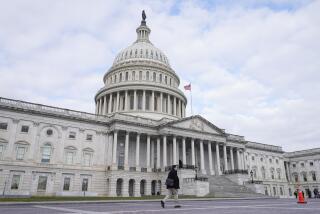Dividend Tax Down, but Not Out, in House’s $550-Billion Plan
WASHINGTON — President Bush’s prized effort to abolish taxes on dividend income was dealt a fresh setback in Congress on Thursday, as House Republicans unveiled a $550-billion tax cut bill that would fall short of that goal.
The bill, backed by GOP leaders who are usually Bush’s staunchest allies on Capitol Hill, would cut, but not eliminate, taxes on dividends. It would diverge from Bush’s priorities by including a cut in capital gains taxes -- an aim long sought by congressional Republicans but omitted from the Bush tax program.
Also, some of Bush’s most popular tax breaks -- for small businesses, married couples and families with children -- would take effect for only three years under the bill; the president wants them on the books until 2013. The three-year limit is one way of keeping the bill’s cost at $550 billion; the president’s entire package would cost about $725 billion.
Administration officials said the bill, expected to be approved by the House next week, is a step in the right direction. But they would not concede defeat in their efforts to entirely eliminate taxes on dividend income.
“We are going to continue to fight for all the elements of the president’s plan, which includes 100% abolition of the tax on dividends,” said Commerce Secretary Don Evans.
House Ways and Means Committee Chairman Bill Thomas (R-Bakersfield), principal author of the House bill, said the administration and its allies needed to accept the fact that the budget resolution approved by Congress last month was too tight to accommodate the $396-billion plan to eliminate dividend taxes.
“They can’t have their old plan,” Thomas said.
Under the budget resolution, the House is writing a bill to cut taxes by $550 billion through 2013, in deference to lawmakers’ concerns about the growing federal budget deficit. In the Senate, where anti-deficit sentiment is even stronger, the tax cut is limited to $350 billion.
The White House is hoping that at the least, final congressional negotiations will produce the $550-billion cut.
The House tax bill includes all the major elements of Bush’s plan -- albeit truncated in some instances -- as well as some additional business tax breaks favored by congressional Republicans.
Major provisions of the bill would:
* Speed up the scheduled reduction in income tax rates that were approved in 2001 but, under that law, are phased in over many years. Rates that were to take effect in 2006 would now kick in for 2003.
* Increase from $600 to $1,000 the tax credit that families could take for each child.
* Speed up to 2003 scheduled tax relief for married couples. Under the 2001 law, provisions to ease the so-called marriage penalty would not begin providing such relief until 2005, and would not be fully in effect until 2009.
* Provide expanded tax relief for small businesses and new tax incentives to invest in computers and other equipment.
To curb the cost of the tax cut, the bill resorts to a bookkeeping maneuver: The provisions on the child-credit, marriage-penalty and business tax relief all would apply only for 2003-2005, while other provisions -- including the dividend and capital gains cuts -- would apply to the full 11-year term of the bill.
Critics denounced the maneuver as gimmickry. “The so-called increase in the child credit is a hoax,” said Rep. Charles B. Rangel of New York, ranking Democrat on the Ways and Means Committee. “Like a magic trick, it’s there and then it’s gone again.”
Thomas acknowledged that the three-year limit on the politically popular family tax breaks was not intended to stand as policy. “No one believes there will be any difficulty in extending them,” he said.
Most of the controversy about Bush’s proposal has centered on the dividend tax cut. He believes that plan would give a boost to the stock market and stimulate economic growth.
He also promotes it as matter of principle on which it is hard to compromise: He wants to get rid of what he calls the “double taxation” of dividends -- the fact that taxes on profits are often paid twice, first by the corporation and then by shareholders when they receive dividends.
But because the price tag of eliminating dividend taxes is so high, Republicans have been looking for ways to trim its cost to leave room for other priorities. The idea initially got a cool reception from Republicans in Congress in part because it was a relatively new idea without a strong constituency in Congress -- unlike, for example, tax relief for married couples, an issue long pushed by conservative family groups.
The compromise endorsed by House Republican leaders would reduce and simplify taxes on investment income. Under current law, dividends are taxed as ordinary income, while taxes on capital gains are 20% for most taxpayers and 10% for lower-income people. Under the House bill, taxes on both dividends and capital gains would be 15% for most people and 5% for lower-income people.
It is a compromise that pleased the many House Republicans who long have championed a reduction in capital gains taxes -- and had privately expressed disappointment that it was not part of the president’s plan.
The House bill also was good news for high-technology companies, which were lukewarm about the president’s dividend tax cut because many of them do not offer dividends.
But it was criticized by die-hard proponents of eliminating all dividend taxes.
“The dividend tax repeal is the main engine of growth in the president’s jobs and growth package,” said Paul Beckner, president of Citizens for a Sound Economy. “I say to the administration and Congress: Don’t stunt the growth in the growth package.”
More to Read
Get the L.A. Times Politics newsletter
Deeply reported insights into legislation, politics and policy from Sacramento, Washington and beyond. In your inbox three times per week.
You may occasionally receive promotional content from the Los Angeles Times.










